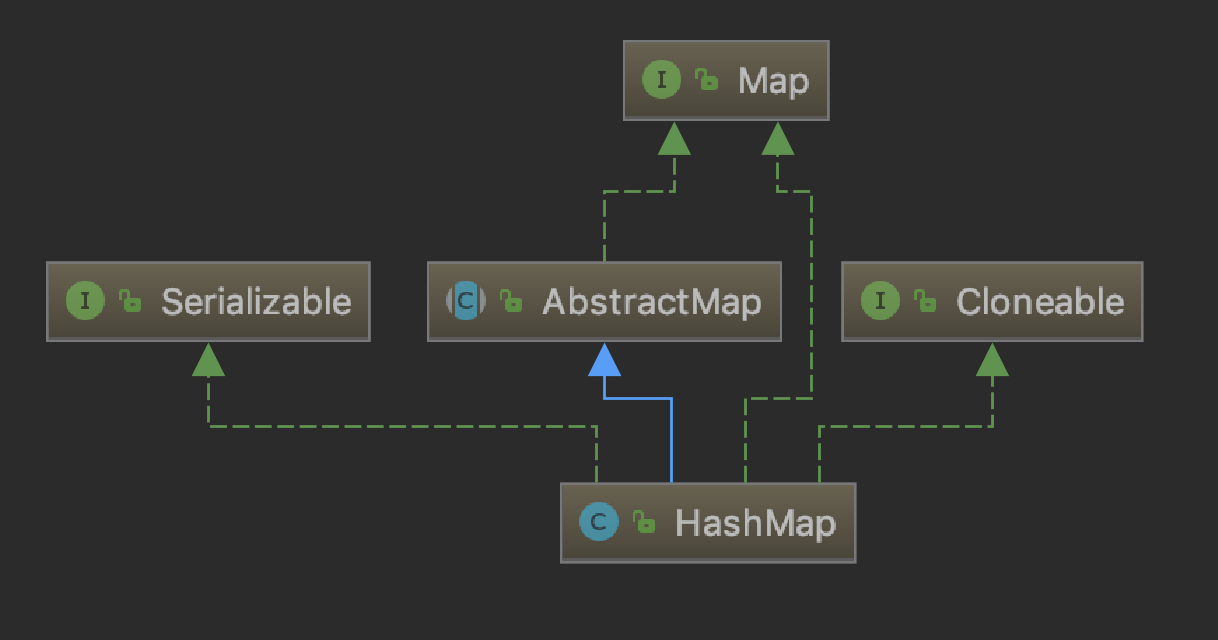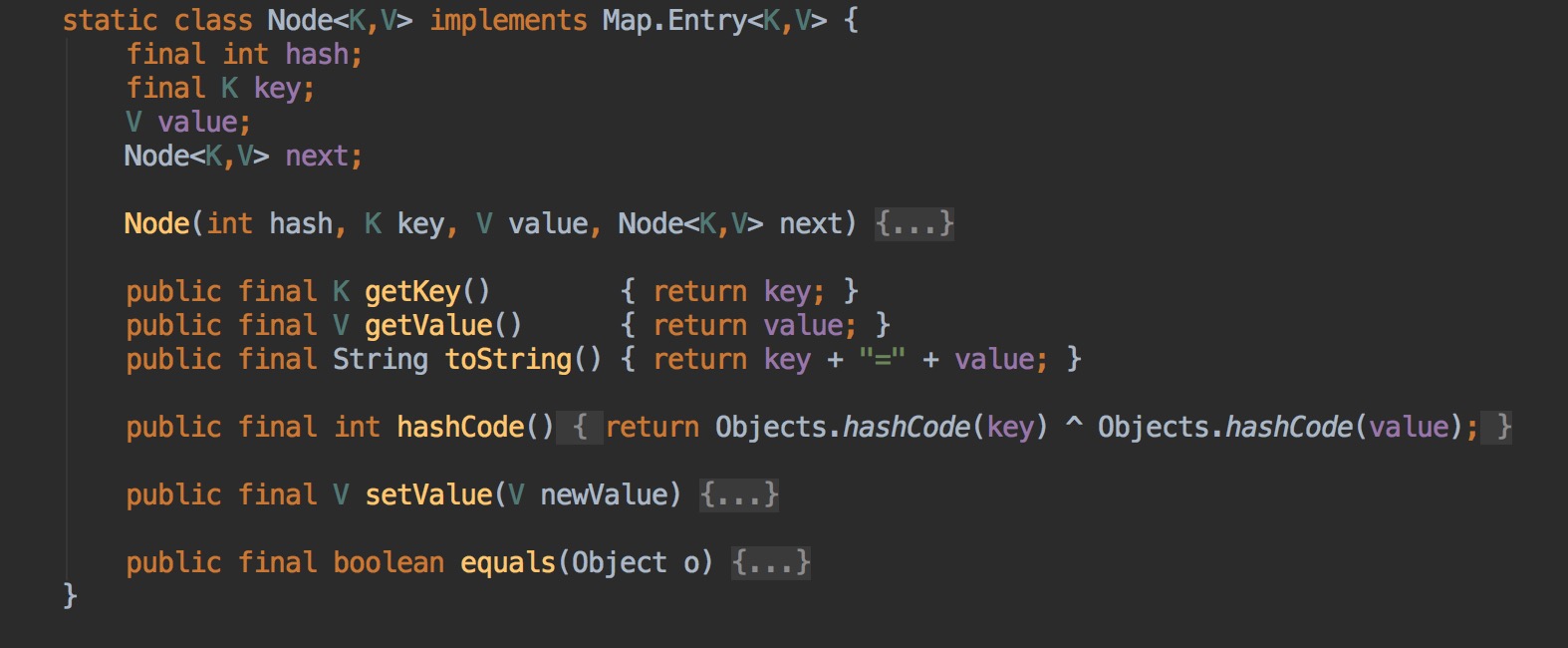声明:本文使用JDK1.8
HashMap 是我们平时开发过程中使用最多的 Java 集合框架之一,它继承 AbstractMap,实现 Map 接口,是一种 key-value,并允许使用空值和空键。
1 2 public class HashMap <K ,V > extends AbstractMap <K ,V > implements Map <K ,V >, Cloneable , Serializable {
从结构实现来讲,HashMap 是 数组+链表+红黑树 (JDK1.8增加了红黑树部分)实现的,相比于Java7,Node可以被扩展成TreeNode。
HashMap类加载 1 2 3 4 5 6 7 8 9 10 11 12 13 14 15 16 17 18 static final int DEFAULT_INITIAL_CAPACITY = 1 << 4 ;static final int MAXIMUM_CAPACITY = 1 << 30 ;static final float DEFAULT_LOAD_FACTOR = 0.75f ;static final int TREEIFY_THRESHOLD = 8 ;static final int UNTREEIFY_THRESHOLD = 6 ;static final int MIN_TREEIFY_CAPACITY = 64 ;transient Node<K,V>[] table;static final int hash (Object key) int h; return (key == null ) ? 0 : (h = key.hashCode()) ^ (h >>> 16 ); }
对于HashMap初始化的容量是16的原因,可以看这里:漫画:什么是HashMap? ,
可以了解下 漫画:高并发下的HashMap ,不过这里的代码比较老。HashMap 在高并发下出现死锁,主要发生在 rehash 时,链表出现环链了。不过在Java8 中,对于链表超过8时,转化为红黑树,这有效的防止这个问题。
tableSizeFor 1 2 3 4 5 6 7 8 9 static final int tableSizeFor (int cap) int n = cap - 1 ; n |= n >>> 1 ; n |= n >>> 2 ; n |= n >>> 4 ; n |= n >>> 8 ; n |= n >>> 16 ; return (n < 0 ) ? 1 : (n >= MAXIMUM_CAPACITY) ? MAXIMUM_CAPACITY : n + 1 ; }
这个方法被调用的地方:
1 2 3 4 5 public HashMap (int initialCapacity, float loadFactor) this .loadFactor = loadFactor; this .threshold = tableSizeFor(initialCapacity); }
当实例化 HashMap 实例时,如果给定了 初始容量initialCapacity,由于 HashMap 的 capacity 都是 2 的幂,因此这个方法用于找到大于等于 initialCapacity 的最小的2的幂。
Node Java8中相对之前的版本增加了Node,从代码中可以看出,是一个哈希桶数组,实现Map.Entry接口,是一个键值对。
key 和 index 在 HashMap 中,下标的选择是计算key的hash值,具体公式是:(n - 1 ) & hash 。其中 n 是 hashmap table[] 数组的长度,hash 是当前key的hash值。& 是与运算,两个数都转为二进制,然后从高位开始比较,如果两个数都为1则为1,否则为0。详细的可以看之前的那篇链接。
hasCode 和 equals HashMap 重写了 hasCode 和 equals,源码如下:
1 2 3 4 5 6 7 8 9 10 11 12 13 14 public final int hashCode () return Objects.hashCode(key) ^ Objects.hashCod(value); } public final boolean equals (Object o) if (o == this ) return true ; if (o instanceof Map.Entry) { Map.Entry<?,?> e = (Map.Entry<?,?>)o; if (Objects.equals(key, e.getKey()) && Objects.equals(value, e.getValue())) return true ; } return false ; }
hash HashMap 的 hash 计算方法。key的hash值高16位不变,低16位与高16位异或作为key的最终hash值。h>>>16 无符号右移16位,高位补0,任何数跟0异或都是其本身,因此key的hash值高16位不变。异或位运算(0 ^ 1 得 1、1 ^ 1 得 0、0 ^ 0 得 0、1 ^ 0 得 1)
1 2 3 4 static final int hash (Object key) int h; return (key == null ) ? 0 : (h = key.hashCode()) ^ (h >>> 16 ); }
初始化 HashMap提供三种初始化HashMap:
1 2 3 4 5 6 7 8 9 10 11 12 13 public HashMap () this .loadFactor = DEFAULT_LOAD_FACTOR; } public HashMap (int initialCapacity) this (initialCapacity, DEFAULT_LOAD_FACTOR); } public HashMap (Map<? extends K, ? extends V> m) this .loadFactor = DEFAULT_LOAD_FACTOR; putMapEntries(m, false ); }
get相关 get方法 1 2 3 4 5 6 7 8 9 10 11 12 13 14 15 16 17 18 19 20 21 22 23 public V get (Object key) Node<K,V> e; return (e = getNode(hash(key), key)) == null ? null : e.value; } final Node<K,V> getNode (int hash, Object key) Node<K,V>[] tab; Node<K,V> first, e; int n; K k; if ((tab = table) != null && (n = tab.length) > 0 && (first = tab[(n - 1 ) & hash]) != null ) { if (first.hash == hash && ((k = first.key) == key || (key != null && key.equals(k)))) return first; if ((e = first.next) != null ) { if (first instanceof TreeNode) return ((TreeNode<K,V>)first).getTreeNode(hash, key); do { if (e.hash == hash && ((k = e.key) == key || (key != null && key.equals(k)))) return e; } while ((e = e.next) != null ); } } return null ; }
contains 1 2 3 4 5 6 7 8 9 10 11 12 13 14 15 16 17 public boolean containsKey (Object key) return getNode(hash(key), key) != null ; } public boolean containsValue (Object value) Node<K,V>[] tab; V v; if ((tab = table) != null && size > 0 ) { for (int i = 0 ; i < tab.length; ++i) { for (Node<K,V> e = tab[i]; e != null ; e = e.next) { if ((v = e.value) == value || (value != null && value.equals(v))) return true ; } } } return false ; }
put put函数是想HashMap中添加键值。
1 2 3 4 5 6 7 8 9 10 11 12 13 14 15 16 17 18 19 20 21 22 23 24 25 26 27 28 29 30 31 32 33 34 35 36 37 38 39 40 41 42 43 44 45 46 47 48 49 50 51 52 53 54 55 56 57 58 59 60 61 62 63 64 65 66 67 68 69 70 71 72 73 74 75 public V put (K key, V value) return putVal(hash(key), key, value, false , true ); } final V putVal (int hash, K key, V value, boolean onlyIfAbsent, boolean evict) Node<K,V>[] tab; Node<K,V> p; int n, i; if ((tab = table) == null || (n = tab.length) == 0 ) n = (tab = resize()).length; if ((p = tab[i = (n - 1 ) & hash]) == null ) tab[i] = newNode(hash, key, value, null ); else { Node<K,V> e; K k; if (p.hash == hash && ((k = p.key) == key || (key != null && key.equals(k)))) e = p; else if (p instanceof TreeNode) e = ((TreeNode<K,V>)p).putTreeVal(this , tab, hash, key, value); else { for (int binCount = 0 ; ; ++binCount) { if ((e = p.next) == null ) { p.next = newNode(hash, key, value, null ); if (binCount >= TREEIFY_THRESHOLD - 1 ) treeifyBin(tab, hash); break ; } if (e.hash == hash && ((k = e.key) == key || (key != null && key.equals(k)))) break ; p = e; } } if (e != null ) { V oldValue = e.value; if (!onlyIfAbsent || oldValue == null ) e.value = value; afterNodeAccess(e); return oldValue; } } ++modCount; if (++size > threshold) resize(); afterNodeInsertion(evict); return null ; } final void treeifyBin (Node<K,V>[] tab, int hash) int n, index; Node<K,V> e; if (tab == null || (n = tab.length) < MIN_TREEIFY_CAPACITY) resize(); else if ((e = tab[index = (n - 1 ) & hash]) != null ) { TreeNode<K,V> hd = null , tl = null ; do { TreeNode<K,V> p = replacementTreeNode(e, null ); if (tl == null ) hd = p; else { p.prev = tl; tl.next = p; } tl = p; } while ((e = e.next) != null ); if ((tab[index] = hd) != null ) hd.treeify(tab); } }
扩容 先了解一些字段含义:
1 2 3 4 5 6 int threshold;final float loadFactor;int size; transient volatile int modCount;
看下源码里面扩容的代码:
1 2 3 4 5 6 7 8 9 10 11 12 13 14 15 16 17 18 19 20 21 22 23 24 25 26 27 28 29 30 31 32 33 34 35 36 37 38 39 40 41 42 43 44 45 46 47 48 49 50 51 52 53 54 55 56 57 58 59 60 61 62 63 64 65 66 67 68 69 70 71 72 73 74 75 76 77 78 79 80 81 final Node<K,V>[] resize() { Node<K,V>[] oldTab = table; int oldCap = (oldTab == null ) ? 0 : oldTab.length; int oldThr = threshold; int newCap, newThr = 0 ; if (oldCap > 0 ) { if (oldCap >= MAXIMUM_CAPACITY) { threshold = Integer.MAX_VALUE; return oldTab; } else if ((newCap = oldCap << 1 ) < MAXIMUM_CAPACITY && oldCap >= DEFAULT_INITIAL_CAPACITY) newThr = oldThr << 1 ; } else if (oldThr > 0 ) newCap = oldThr; else { newCap = DEFAULT_INITIAL_CAPACITY; newThr = (int )(DEFAULT_LOAD_FACTOR * DEFAULT_INITIAL_CAPACITY); } if (newThr == 0 ) { float ft = (float )newCap * loadFactor; newThr = (newCap < MAXIMUM_CAPACITY && ft < (float )MAXIMUM_CAPACITY ? (int )ft : Integer.MAX_VALUE); } threshold = newThr; @SuppressWarnings({"rawtypes","unchecked"}) Node<K,V>[] newTab = (Node<K,V>[])new Node[newCap]; table = newTab; if (oldTab != null ) { for (int j = 0 ; j < oldCap; ++j) { Node<K,V> e; if ((e = oldTab[j]) != null ) { oldTab[j] = null ; if (e.next == null ) newTab[e.hash & (newCap - 1 )] = e; else if (e instanceof TreeNode) ((TreeNode<K,V>)e).split(this , newTab, j, oldCap); else { Node<K,V> loHead = null , loTail = null ; Node<K,V> hiHead = null , hiTail = null ; Node<K,V> next; do { next = e.next; if ((e.hash & oldCap) == 0 ) { if (loTail == null ) loHead = e; else loTail.next = e; loTail = e; } else { if (hiTail == null ) hiHead = e; else hiTail.next = e; hiTail = e; } } while ((e = next) != null ); if (loTail != null ) { loTail.next = null ; newTab[j] = loHead; } if (hiTail != null ) { hiTail.next = null ; newTab[j + oldCap] = hiHead; } } } } } return newTab; }
put(K key, V value)的逻辑:
①.判断键值对数组table[i]是否为空或为null,否则执行resize()进行扩容;
②.根据键值key计算hash值得到插入的数组索引i,如果table[i]==null,直接新建节点添加,转向⑥,如果table[i]不为空,转向③;
③.判断table[i]的首个元素是否和key一样,如果相同直接覆盖value,否则转向④,这里的相同指的是hashCode以及equals;
④.判断table[i] 是否为TreeNode,即table[i] 是否是红黑树,如果是红黑树,则直接在树中插入键值对,否则转向⑤;
⑤.遍历table[i],判断链表长度是否大于8,大于8的话,同时需要判断 table 数组大小是否大于64,如果只满足前一个条件,只进行扩容;若果两个条件都满足,把链表转换为红黑树,在红黑树中执行插入操作,否则进行链表的插入操作;遍历过程中若发现key已经存在直接覆盖value即可;
⑥.插入成功后,判断实际存在的键值对数量size是否超多了最大容量threshold,如果超过,进行扩容。
JDK7和JDK8之后,HashMap 的区别?
1.7中采用数组+链表,1.8采用的是数组+链表/红黑树,即在1.7中链表长度超过一定长度后就改成红黑树存储。
1.7扩容时需要重新计算哈希值和索引位置,1.8并不重新计算哈希值,巧妙地采用和扩容后容量进行&操作来计算新的索引位置。
1.7是采用表头插入法插入链表,1.8采用的是尾部插入法。
在1.7中采用表头插入法,在扩容时会改变链表中元素原本的顺序,以至于在并发场景下导致链表成环的问题;在1.8中采用尾部插入法,在扩容时会保持链表元素原本的顺序,就不会出现链表成环的问题了。
Reference



